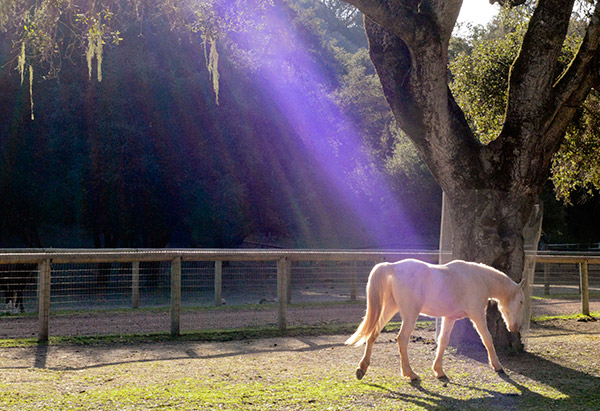Meet Your New Therapist. He's Wise, Compassionate...and Likes to Eat Hay

Photo: Phyllis Lane
PAGE 5
Vanilla, another colleague of Simpson's, takes a stroll through the pasture.
In 2004, when Koelle coached me through a brief interaction with a horse, my whole life changed. I'd had no idea that my tendency toward overworking, perfectionism, and people-pleasing was setting everyone's teeth on edge. But the horse ran from me until I let go of it all.
The more I learn about the subtle ballet of horse communication, the more I appreciate Koelle's skill. Every gesture is meaningful: the speed and direction of her walk, the opening or closing of her fingers, the tension or relaxation of her abdomen. Koelle has trained her eyes not to dart, which she says horses interpret as predatory behavior. She's spent tens of thousands of hours practicing her art, and she is breathtakingly good at it.
I'm reminded of this now, as Avery joins me on the observation deck and we settle in to watch Koelle in action. "So," Koelle says to us, her eyes on the horse. "Ernie and I already know a lot about each other. He can smell my hormones, hear my heartbeat, feel my energy. I can feel him, too. So can you. We're all born with the ability to sense energy. Can you feel that Ernie's still a little amped up?"
Avery agrees that the horse seems anxious, though she can't really say how she knows. It's just a feeling. Koelle asks her to trust it. Then she fixes her gaze onto Ernie's, her chest open and her shoulders squared.
"I'm encouraging him to keep moving. I'm showing him I don't need to catch or confine him," says Koelle. "Running away is his primary defense, and I'm not going to take that from him. I don't want the people I love to come with me because I force them. That's not love; it's control."
Ernie slows down, moving away from the wall and closer to Koelle.
"I'm going to ask him to turn around," she says. "That's something we can do to connect without making him feel confined."
Ernie turns around. It looks to Avery like magic, but Koelle has simply changed the position and angle of her body to subtly block Ernie's forward run and fall behind his flank. Position, speed, tension, angle: all part of horse language.
"Now I'm going to slow things down," says Koelle.
Instantly, Ernie goes from jogging to walking; Koelle has deepened her breathing, softened her belly, dropped her shoulders, and slowed her own movement to suggest he follow suit.
Now Ernie is actively asking to connect with Koelle. One of his ears is locked on her. The muscles of his neck relax, and he briefly bows, dipping his head to his knobby knees. His lips move as if he were chewing gum.
"Since he's requesting it so politely, I'm going to invite him to come be with me," says Koelle. She turns her back to Ernie, walks a few steps, and stops. Abruptly, the horse stops, too. He stands looking at Koelle with his bright, black eyes, then takes a step. Koelle's body looks as soft as a melting candle. Ernie walks up behind her and rests his chin on her shoulder.
Avery is in tears again. This time, so am I.
Next: Finding a place of peace



